This post is part of a draft on palaeolinguistics and the Proto-Uralic homeland. See below for the color code of protoforms.
1. Foraging
1.1. Hunting
PFU (Fi., Ma., Md., Ms., Hu.) *lewi- ‘to shoot’ (UEW Nº 482; Aikio 2019: 47).
PU (Saa., Fi., Md., Ma., Kh., Ms., Hu., Smy.) *je̮ŋsi/*joŋsi ‘bow’ (UEW Nº 190; Aikio 2020: 71 with references).
PU (Saa.? Fi., Ma., Kh., Ms., Hu., Smy.) *jänti(ni) ‘sinew; (bow)string’ (UEW Nº 169; Aikio 2019: 47 with references).
PU (Saa., Fi., Md.., Ma., P, Kh., Ms., Hu., Smy.) *ńe̮li (*ńōle) ‘arrow’ (UEW Nº 622).
PU (Saa. Ma., P, Kh., Smy.) *jäpśe ‘spear’ (UEW № 73).
PU (PKh., PMs., PSmy) aŋti ‘spear / blade’. Possibly also here PUg. *aŋti(-lV) ‘rib’, which Aikio (2018) proposed could have arisen from an obscured compound word from **aŋti-luwi “spear-bone” (Aikio 2020: 24-25).
PFU (Ma., P, Ms., Kh.) *pekše ‘(blunt?) arrow’ (UEW Nº 737). Based on the reconstruction of an *š, possibly an Agricultural Substrate word, but with a widespread distribution in Uralic. With a similar meaning but more limited distribution, cf. PEU (Kh., Ms., Smy.) *muŋkV.
1.2. Fishing
PU (Saa.? Fi., P, Kh., Ms., Hu., Smy.) *kala- ‘to net; to fish with a net’ (UEW Nº 230).
PU? (Saa., Fi., Kh., Ms., Smy.?) *kulta- ‘to fish with a dragnet’ (UEW Nº 388).
PFU? (Saa., Fi., Kh., Hu.) *pado ‘fish weir’ (UEW Nº 687; Aikio 2015: 37).
PU? (Fi, Kh., Ms.) *ajna ‘attachment for fishing nets (?)’ (Aikio 2020: 8-9 with references). Note that PFi. *aina could be from PGmc. *ainja- ‘juniper’, since juniper bark has been used as material for ropes.
PFP (Saa., Fi., Ma.) *oŋki ‘fish-hook’ (UEW Nº 1456) ← LPIE *ank-on, with a precise IE dialectal origin unknown (Holopainen 2019: 161-162 with references).
1.3. Boat
PU (Saa., Fi., Ma., Kh., Ms., Smy.) *suxi- ‘to row (a boat)’ (UEW Nº 911). Probably an early PIE borrowing (see Earliest External Contacts).
PU (Saa., Ma., P, Kh., Ms., Hu., Smy.) *tukta ‘to seat in a boat’ (UEW 1072).
PWU (Saa., Fi., Md.) *weneš (UEW Nº 1703) ‘boat’ ←? Pre-PIIr. **wen-e/o-? → PIIr. *wana- (cf. O.Ind. vána- ‘wood, tree, timber; wooden vessel’) → POUg. *wǟnV ‘forest’. Its adoption could be related to trade of wood and river connections or to the chariot, or maybe also to a religious theme (see Mythology and Metallurgy).
PWU (Fi., Md.) *šakče ‘boat’ (UEW Nº 1605).
PU (Saa., Fi., Md.?, Ma.?, P, Kh.?, Ms.?, Smy.) *joke ‘river’ (UEW Nº 186).
PFP (Saa., Fi., Md., Ma.) *järwä ‘lake’ (UEW Nº 1244) ← Pre-PBSl. *jouro- or PBSl./PBal. *jaurā ‘marsh land’ (cf. Lith. jáura ‘marsh, peatsoil’). Since there were no diphthongs in PU, and -rw- was possible from PIE to Baltic languages, the most likely direction of borrowing is from IE to Uralic (Junttila 2012: 29). It might have replaced PU (P, Kh., Mns., Hu., Smy.) *towV ‘lake, pond’ (UEW Nº 1070).
NOTE. Nevertheless, assuming the necessary metathesis for PFP also opens the door for a metathesis in (P?)Bal., no matter if it is a priori unnecessary. The apparently regular cognates in Finno-Permic are striking, and makes the borrowing dubious unless it can be reconstructed for PBSl. The isolated Lith. jáura can be traced back to a full-grade (Pre-)PBSl. *jour-, a regular derivation of PIE *ueh₁r (cf. CLuv. wā́r ‘water’, Skt. vā́r ‘id.’, YAv. vāra- ‘rain’), from the same root as *wedr- ‘water’ (Lubotsky 2012). It must be an old formation, since it probably contaminated – with an initial *j – the zero-grade forms in *uh₁r-, cf. Lith. jū́ra ‘sea’, Latv. jũra ‘id.’ (Derksen 2015: 209, 215); compare here PGmc. *u(w)ur- ‘drizzle’ (Kroonen 2013: 562). Slavic derivatives such as PSlav. *jьrъ ‘warm lands to which birds migrate (?)’, with formations in *vъ, are highly uncertain (Derksen 2008: 213). The whole Balto-Slavic word set is suspicious of belonging with Uralic contacts, one way or another.
1.4. Manufacture
PU (Saa., Fi., Ma., P, Smy.) *ďimä ‘(animal) glue’ (UEW Nº 123).
PU *ćejŋi/*ćijŋi ‘jewellery, ornament’, proposed in Aikio (2020: 118-119 with references).
PFU (Fi., Kh., Ms.) *oδa ‘pole; spear’, cf. PFi. *ote̮le̮- ‘spear’, PKh. *ɔ̄ḷ ‘pole’, PMs *ulā ‘post’ (Aikio 2020: 67-68 with references). Comparable to PIE developments from staff to spear, possibly originally meaning ‘pole’.
PU (Saa. Md., P, Ms., Kh., Smy.) *ulki ‘pole’ (Aikio 2020: 86-88 with references), cf. PSaa. *olke̮, PMd. *olgǝ/*olg(ǝ), PP *ĭ̮l, PMs. *ī̮wlā, PKh. *uɣǝl/*ūɣǝl, PSmy. *uj (Aikio 2020: 86-88 with references).
PU (Saa., Fi., Md., Ma., P, Kh., Ms., Hu.) *će̮lkaw/*śe̮lkaw (*će̮lkaj/*śe̮lkaj) ‘pole, rod’ (UEW Nº 929) ← PIIr. *ćalākā-, cf. Skt. śalā́kā- ‘a chip, fragment, splint, log, piece, bit’, of unclear origin (Aikio 2020: 122-124 with references). Maybe more straightforward *śe̮lkaw/*śe̮lkaj from PBSl. *źalga ‘stick, pole’ or Pre-PBSl. *gʲʰalgo- or *gʲʰalgā, cf. O.Lith. žalgà ‘pole’ (Koivulehto 2001; Bjørn 2017: 57; Kallio ms. in Holopainen 2019: 250-252 with references).
Maybe here PWU (Fi., Md.) *ćolki ‘clasp, buckle’ (UEW Nº 1592) from the same PIIr. root *ćalā (or less likely from PIIr. *śalā- ‘rod, stick’), but the semantic variation and syncope render it dubious (Aikio 2020: 133-134 with references; Holopainen 2019: 252-253 with references).
2. Animals
2.1. Birds
PU (Saa., Fi., Md., Ma., P, Kh., Ms., Hu., Smy.) *pesä ‘nest’ (UEW Nº 753).
PU (Saa., Fi., Md., Ma., P, Kh., Ms., Hu., Smy.) *muna ‘egg; testicles’ (UEW Nº 561). The word belongs here according to Aikio (2019: 46).
PU (Saa., Md., P, Kh. Ms., Hu. Smy.) *tulka ‘feather; wing’ (UEW Nº 1075).
Pre-PP *peträ/*pertä ‘wing’ ← Pre-PIIr. *petro- ‘wing’. The borrowing looks ancient (possibly earlier than *mertä and *kertä, v.i.), but it is extant only in Permic (Holopainen 2019: 180-181 with references).
PFU *ćäkći ‘osprey’ (UEW Nº 946; Aikio 2020: 112 with references).
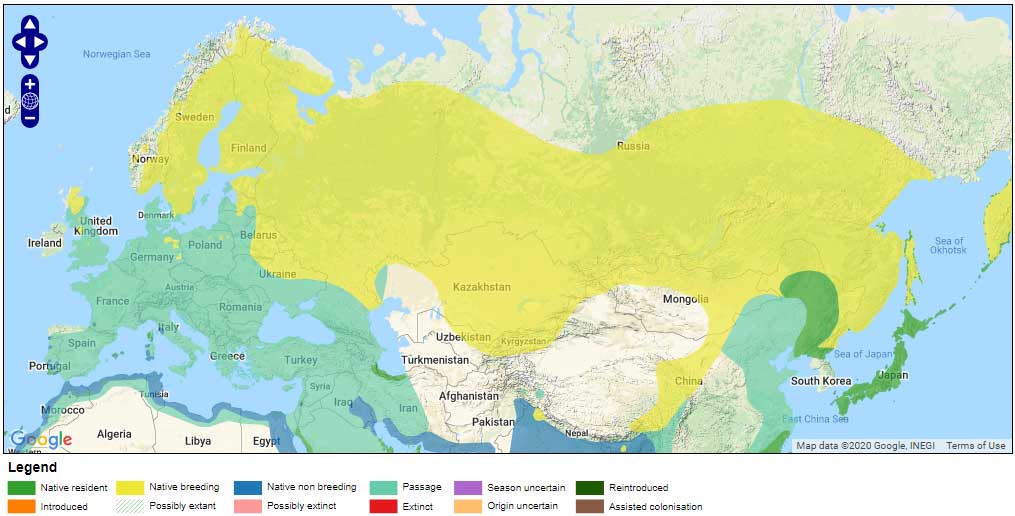
PFU (Saa., Fi., Md., Ma., P, Kh., Ms.) *ćoδka ‘common goldeneye’ (Aikio 2020: 130 with references).
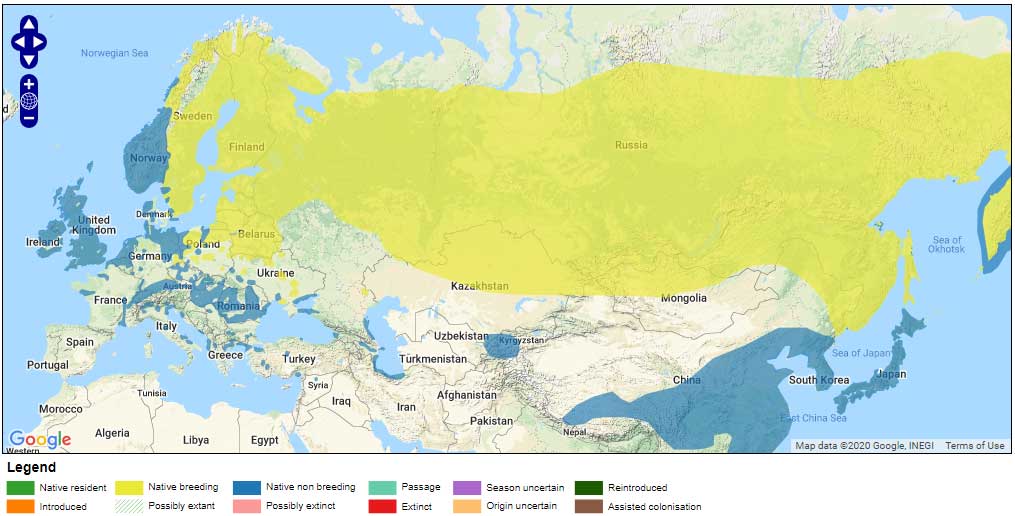
PU? (Saa., Fi., Md., Smy.?) *kurki/*ke̮rki ‘crane’ (UEW Nº 245; Aikio 2019: 46 with references).
PFU (P, Kh., Ms., Hu.) *te̮rka/*tar(i)-ki? ‘crane’ (UEW Nº 1032).
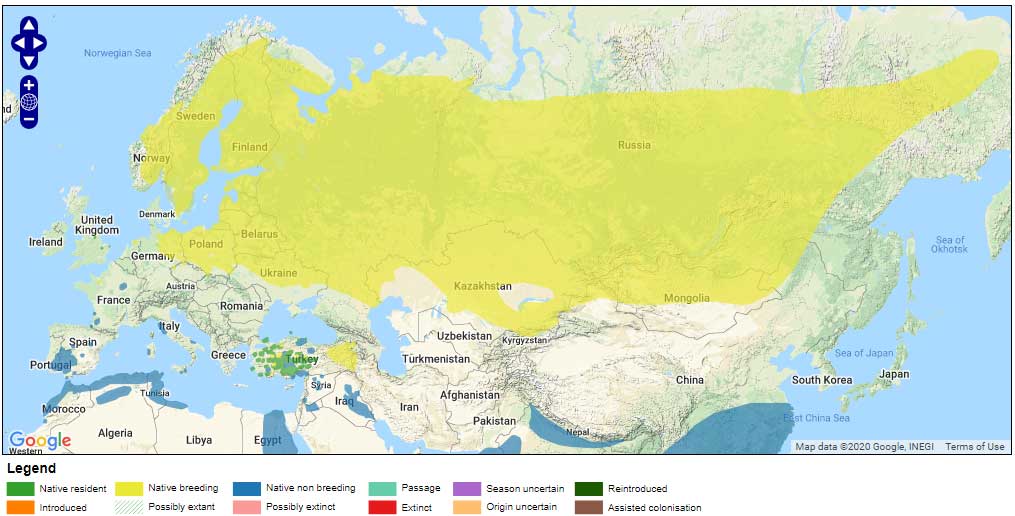
PFU (Saa., Kh., Ms.) *epik(i) ‘(eagle) owl’ (Aikio 2019: 46 with references).
PFi. *hǖpjä ‘eagle owl’ shows irregular initial *h and cluster *pj, suggesting a substrate word (Aikio 2020: 47 with references).
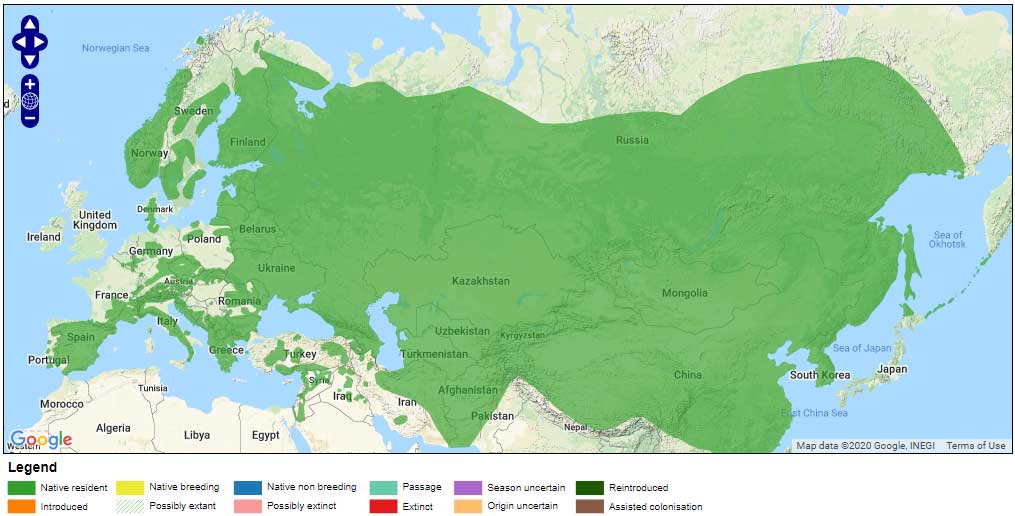
PFU (Fi? Saa., Ma., P, Kh., Ms.) *te̮ktV/*tuktV ‘diver, diving duck; black-throated loon’ UEW (Nº 1062).
NOTE. It seems unwarranted the narrowing of meaning that Aikio (2019: 46) selects for this word, as “black-throated loon” – with palaeolinguistic purposes (see modern range below) – given the extant, more general meanings found in Saa., Ma., P (and Kh.?) derivatives. In fact, multiple works that have referenced this word from the UEW (“Taucher, Seetaucher – Columbus arcticus”) have selected a more general – and logically much more likely – meaning PU ‘(diving) duck’.
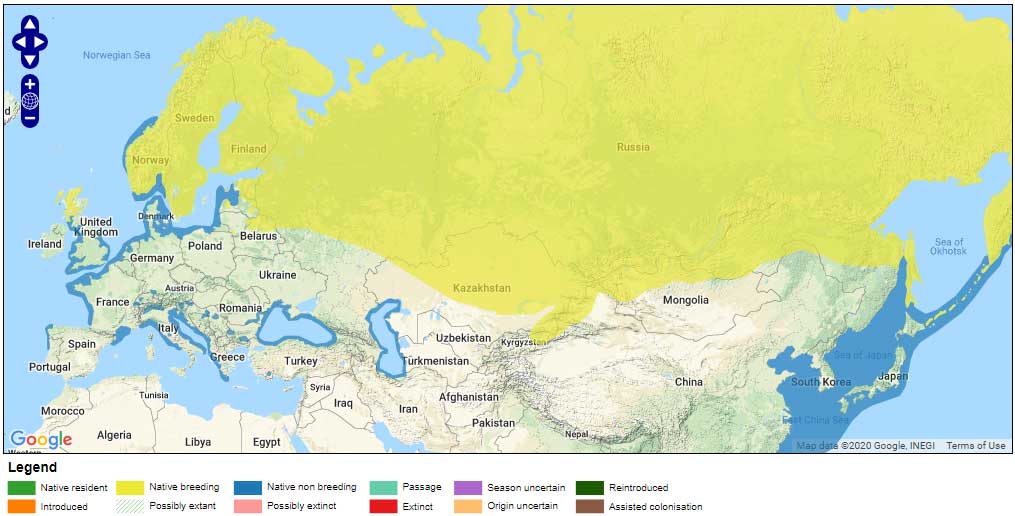
PFU? (Saa., Fi., Md., Ma., P) *kočka ‘eagle’, cf. PTurk. *küčigen (UEW Nº 1322; Pystynen 2017).
PFU? (Saa., Fi., Md., Ma., P, Ms.?) jo(ŋ)kće?/ńokśi? ‘swan’ (UEW Nº 189), maybe here Mns. †josch-woi, possibly a substrate word (Pystynen 2017).
PFU (Saa., Fi., ma., Kh., Ms., Hu.) *lunta ‘goose’ (UEW Nº 497).
PFU? (Fi., Saa?, Md., Ma., P, Kh.?, Ms.?) *kärke?/*karV ‘woodpecker’ (UEW Nº 1285).
PFP (Saa., Ma., P) ćäćnä ‘woodpecker’ (UEW Nº 1585), cf. PSaa. *čāšnē, PMa. *šištǝ, PP *śĭźvs. The cluster *ćn is exceptional, and no derivational suffix *-nA is known, hence likely borrowed from an unknown language (Aikio 2020: 108 with references).
2.2. Mammals
PU (Saa., Md., P, Hu., Smy.) *ńoma(-la) ‘hare’ (UEW Nº 636).
PU (Fi., Md., P, Kh., Ms., U., Smy.) *šiŋir(i) ‘mouse’ (UEW Nº 1005; Aikio 2015). Based on the reconstruction of an *š, a potential Agricultural Substrate word, but with a widespread distribution in Uralic.
PU (Saa., Fi., Md., Ma., P, Smy.) *ora (*orapa/*orawa) ‘squirrel’ (UEW Nº 677; Aikio 2020: 78 with references).
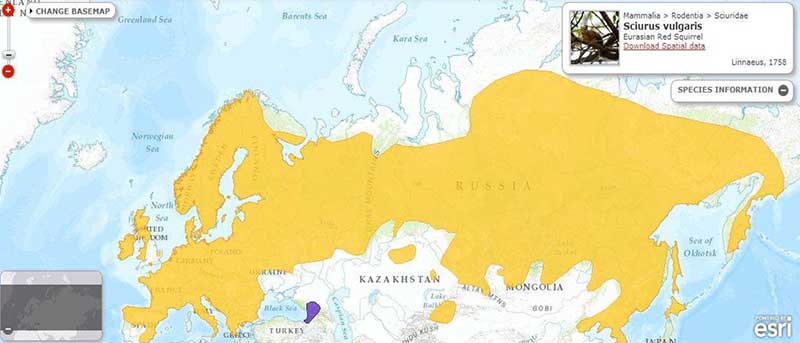
PU (Fi., Md., Ma., Ms., Hu.) *ćijilV/*ćüjilV ‘hedgehog’ (UEW Nº 962; Aikio 2020: 127-128 with references).

PU (Fi., P, Kh., Ms., Hu., Smy.?) *ńukiś(i) ‘marten; sable’ (UEW Nº 645; Aikio 2019: 46).
PU (Ma., Ms.?, Smy.) *lujV ‘(pine) marten; sable’ (UEW Nº 494).
PU (Fi., Md., P) *majaka/*mejä(kä) ‘beaver’ (UEW: 697; Sammallahti 1988: 552), suspected by Aikio (2015: 46) to belong to the Agricultural Substrate based on its “distribution, meaning and phonological irregularity”(?). Compare with PUg. *kuntV ‘beaver’ (UEW Nº 1781; Pylstynen 2017).
NOTE. The beaver’s range probably still covered most of Eurasia (except for the Arctic circle) during the Neolithic and Bronze Age, based also on its reconstruction for Proto-Indo-European, so its borrowing (on either side of the Urals) probably had to do with its main role in the fur trade, unless one word (or both) belonged to a different species or had a slightly different meaning.
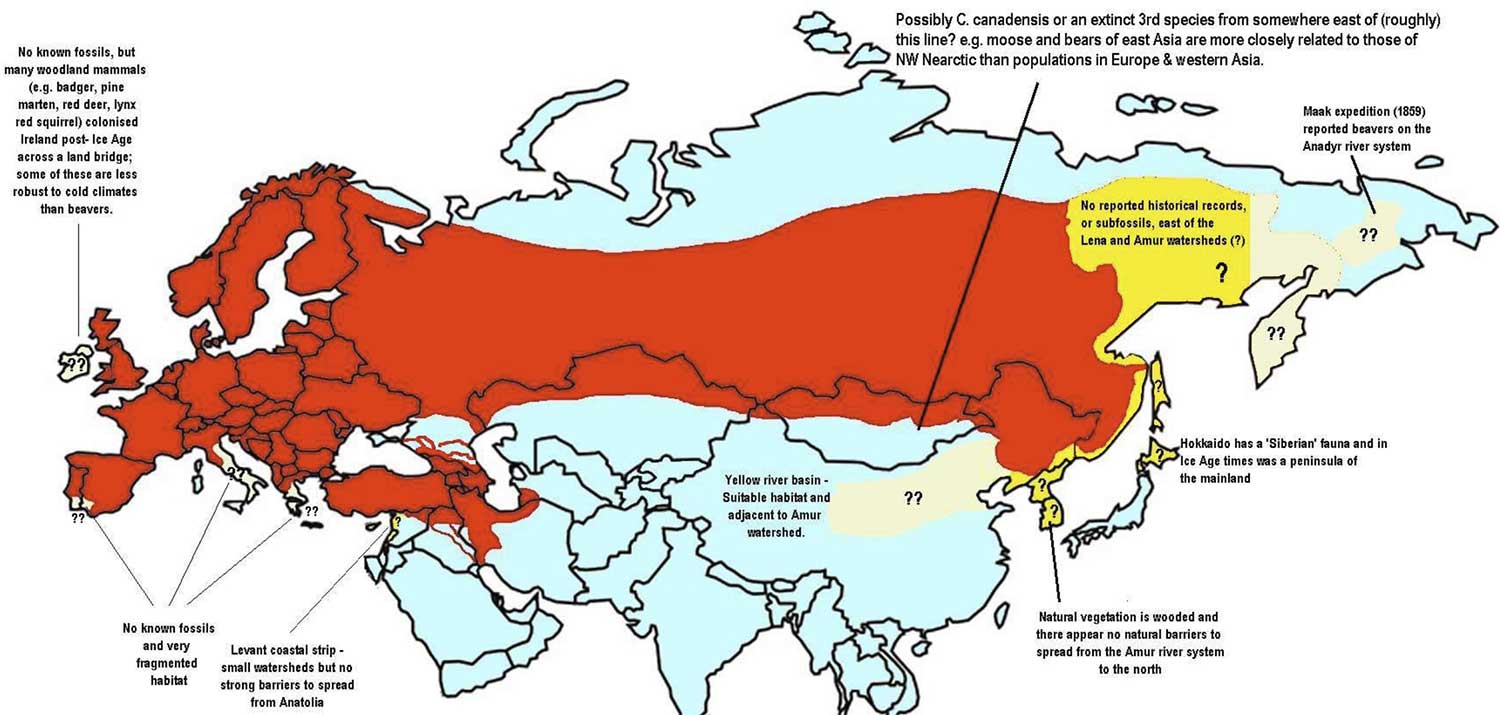
PU (Fi., Ma., Smy.?) *šäškä ‘otter’ (UEW 498). Based on the reconstructible *š, suspicious of an Agricultural Substrate word. Most likely borrowed into Baltic, cf. Lith. šẽškas, šẽškus ‘polecat (Mustela putorius)’, Latv. sęsks, sęskus ‘id.’ (ALEW 1779, Junttila 2015: 28).
NOTE. After rejecting that Samoyedic forms belong here, Aikio (2015:45) considers that this word meant ‘European mink’, which is not warranted based on current derivatives and the Baltic loanword.

PU (Saa. ←? Fi., Md., Ma., P, Hu, ) *repäć(i)/*ra/opać(V) ‘fox’ (UEW Nº 859) ← Pre-PIIr. *reup-ēćo-/roup-ēćo- → PIIr. *raupāćá-, from PIE *h₂lo(u)p-. There could have been as far as three independent and quite early borrowing events – Pre-PFi., Pre-PP, and PUg. – from (Pre-)PIIr. (Palmer et al. 2021). This has been proposed to be related to the relevance of fur trade with steppe populations (Holopainen 2019: 201-206 with references).

PWU? (Fi., Md.) *okti? ‘bear’ from PFi. *oktoi, PMd. *ovt(ǝ) (Aikio 2020: 71-72 with references). Reminiscent of LPIE *(h₂)r̥któs ‘bear’ (cf. Gk. ἀρκτικός), but with no clear phonetic explanation or dialectal path of borrowing, if any.
Pre-PMd.? *wərkas ‘wolf’ ← PIE/(Pre-)PIIr. or even early PIr. *wr̥ka- ‘wolf’ → Pre-PSmy.? *wurka ‘bear’, possibly both related to Northern Eurasian taboos (Holopainen 2019:315-316 with references).
PFP (Saa., Fi., Md., Ma., P, Hu.?) *pene ‘dog’ (UEW Nº 743).
NOTE. The proposal of a loan from “Pre-PIIr.” **kʲwena- by Katz (2003) seems unsubstantiated. A change PU *p ← PIE *kʷ could make sense, especially in light of Proto-Sino-Tibetan *d-kʷəj-n (hence from a potential North Eurasian Wanderwort), and the highly dubious loan of ‘horse’ in Pre-PFi (v.i.). However, the existence of an unattested e-grade, which should have been prevalent in a Pre-Proto-Indo-Iranian stage, is very unlikely.
PUg. (Kh., Ms., Hu.) *ämpV (*empV) ‘dog’ (UEW Nº 1730).
PFU (Ma., P, Ms., Kh.) *optV- ‘to bark’ (Pystynen 2017).
These three words show that domesticated dogs probably played an important role in the Proto-Uralic community. The lack of parallel reconstructs for ‘wolf’ or ‘howl’ might indicate a shift in meaning, but the taboos in place for wild animals (Grünthal 2004) and the parallel examples in Proto-Indo-European makes this unlikely.
For the origin and spread of dogs, see e.g. Frantz et al. (2016), Ollivier et al. (2018). The spread of Corded Ware dogs (with a 3.8-ka-old Srubnaya-related dog as proxy) probably accompanied the spread of Corded Ware ancestry, because it is found in a 4.7-ka-old Corded Ware-associated dog from Germany. Their genetic impact is visible today mainly in Northern and Eastern Eurasia, paralleling the early evolution of Corded Ware ancestry among Uralic peoples and Indo-Iranians. In Europe, dogs were almost fully replaced by a Neolithic breed (with a 5-ka-old dog from Megalithic Sweden as proxy), possibly starting as early as the Bell Beaker expansion, but maybe even earlier with the Yamnaya, based on a 4-ka-old Bronze Age dog from Italy and a 1.5-ka-old dog from Turkey (Bergström et al. 2020).
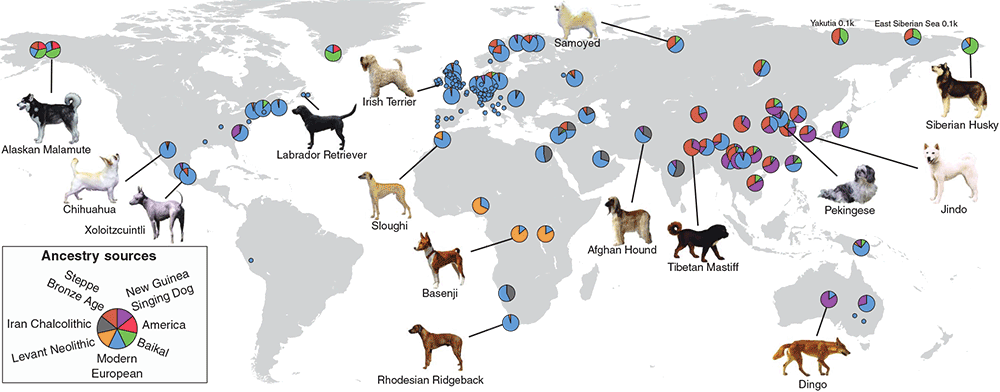
Absent mammals
PU? (Md, Ma.?, Kh.) *ćarta ‘deer; moose; young reindeer’ (UEW Nº 936), a central word that was possibly borrowed in Mansi from PKh., in turn possibly an irregular development (Aikio 2020: 106-107 with references).
PFU (Saa., Fi., Ma., P. Ms., Hu.) *ćarwi/*śarwi ‘horn’ (UEW Nº 978) ← PIIr. *ćr̥wā- ‘nail, horn’. Here also Pre-POUg. *ćarapa/*śarapa ‘elk’ ← PIIr. *ćarabʰás ‘horned animal’ (cf. O. Ind. śarabʰá), from the same root PIIr. *ćar-. Possibly replaced a PEU? *ańta? ‘antler’, found as PMs. *ī̮ńtǝ and PSmy. *amtǝ̑, both in turn phonetically difficult to reconcile (Holopainen 2019: 220-222 with references; Aikio 2020: 19-20 with references).
Words like PU? (Fi.?, Hu.?, Smy.) *tewa ‘moose, reindeer’ (UEW Nº 1051), PU? (Saa., Mns., Smy.?) *kunta ‘wild; wild reindeer'(UEW 401), etc. show irregular phonological correspondences and limited distribution between dialects with recent (direct or indirect) cultural contact with reindeeer herding. The only words of reindeer (herding) showing a more regular correspondence belong, in fact, to the agricultural layer of borrowings, and referred originally to cattle (v.i. Animal Husbandry).
NOTE. The lack of a proper reconstructible Proto-Uralic word for ‘reindeer’ is hardly a proof of its lack of existence in the Urheimat, since the many derivatives with limited distribution today meaning ‘elk’, ‘moose’, ‘deer’, or ‘reindeer’ could have been originally used to designate any of them in the parent language. Similarly, the lack of existence of a clear Uralic word for ‘cow’ or ‘horse’ isn’t a proof of its lack of existence in the parent language, either. However, a loss of the many assumed words for reindeer (herding) in most dialects is difficult to reconcile with the proposal of a continuous presence in a Siberian environment, and particularly with a late expansion of Finno-Permic after reindeer domestication.
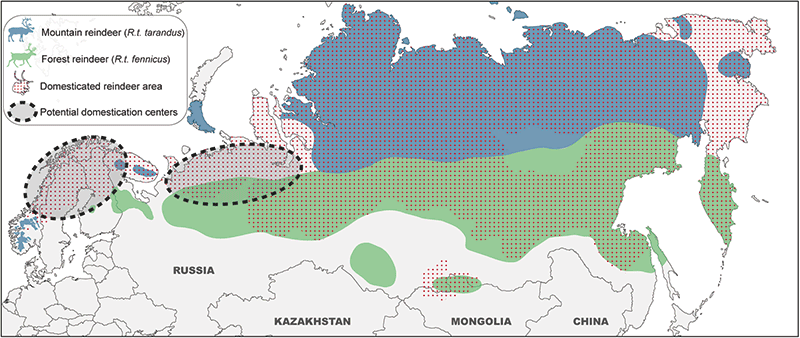
The ancient substrate nature of all words for ‘seal’ and the presence of multiple borrowings in Uralic languages might also be helpful to set a limit to their ancient location – well outside of the Arctic Circle, the North Sea, and the Baltic Sea shores – based on the most likely subsistence economy of Mesolithic and Neolithic populations of those areas:
- PFi. *šülkeš ← Pre-PFi. **še̮lkeš ‘seal’ → Pre-PGmc. **selkos → PGmc. *selhaz (also proposed as *šülxeš/*šülxes → *selhaz by Jochem Schindler). Iversen & Kroonen (2017) considered it a likely common substrate word from the Pitted Ware culture.
- Saami dialects show different derivatives based on a word for ‘wolf’ (themselves borrowings from Indo-European): Ter Saami vīrre ‘seal; wolf’ ← Russ. zver’; Skolt Saami näúdd ‘seal; wolf’, North Saami návdi ‘wolf; creature, fur animal; beast’ ← (PFi. *nauta ←) PGmc. *nautą ‘property’, cf. ON naut ‘cattle, beef’ (Grünthal 2004).
- Nenets shows nyak, while the Eskimo word is nesak, part of a substrate vocabulary adopted from circumpolar aboriginals (Vajda 2002).
NOTE. Regarding the Germanic suffix *-ko found in animal names, Kroonen (2013, passim) had previously made an unsubstantiated proposal of a potential parallel in the isolated PIE *h₂r̥t-ko-. Other known examples include PGmc. *el-ha(n)-/*algi- ‘elk’ (maybe from the root in PIE *el-en- ‘deer’) and *baru-ga- ‘barrow’ (from *bʰoru, found in Slavic, cf. Russ. bórov ‘hog, castrated boar’), both potentially from a substrate language (v.i. Pigs & Boars).
2.3. Fish
PU (Saa., Fi., Md. Ma. Kh. Ms., Hu., Smy.) *kala ‘fish’ (UEW Nº 228) ~ PIE *(s)k(ʷ)alos ‘fish’ could be a loanword in any direction or a shared Indo-Uralic stem, but Koivulehto (1995) or Schrijver (1999) preferred a Uralic form as the original, the PIE form as borrowed.
PFU/PU? (Saa. Fi., P, Kh., Ms.) *kuďi- ‘spawn’ (UEW Nº 379). Maybe also here Tung. gad-da ‘spawn’, hence from a lost PSmy. form?
PFU (Saa., Fi., P, Kh., Ms.) *śi̮mi (*śōme) ‘scales, fish skin’ (UEW Nº 958).
PFU (Fi., Md., Ma., Kh., Ms.) *ćäkä/*ćekä/*ćeki ‘catfish; burbot’ (Aikio 2020: 111 with references). The distribution of both covers essentially all of North Eurasia.
PFU (Fi., Md., Ma., Kh.?, Ms.?) *särki ‘roach’ (ETY särg).

PFU (Saa., Fi., Md., P, Hu.) *säwni/*sewni ‘ide’ (UEW Nº 886).
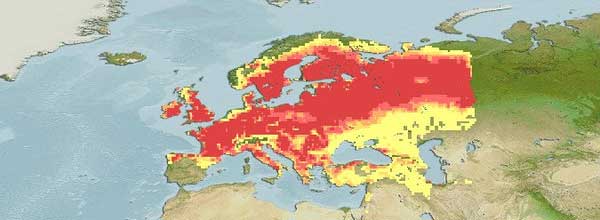
PU (Fi., Md., Ma., Ms., Hu., Smy.) *totki ‘tench’ (UEW Nº 1068).

2.4. Reptiles and Insects
PU (Fi., Md., Ma.?, P, Hu., Smy.) *küji ‘snake’ (UEW Nº 302).
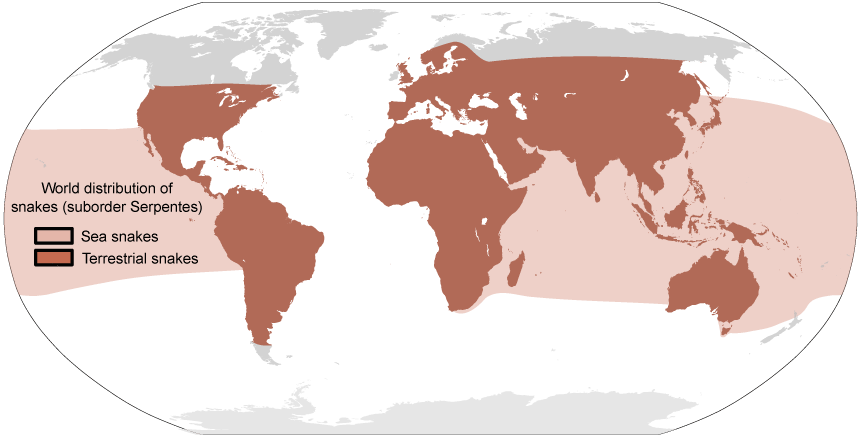
PU (Saa., Fi., Ma., P, Kh. Ms., Smy.) *ćVńćV(-lV)/*tVńćV(-lV)? ‘lizzard’ (UEW Nº 920; Aikio 2020: 153-154 with references).
PFU (Saa., Fi., Ma., P, Kh., Ms. Hu.) *täji ‘louse’ (UEW Nº 1035).
PWU (Saa., Fi., Md.) *će̮ćki/*ćäćki ‘mosquito’ (UEW Nº 1584; Aikio 2020: 122 with references).
PFU (Fi., Ma., P, Kh., Ms.) *owδimi(?) ‘mosquito curtain’ (UEW Nº 1087; Aikio 2020: 81-82 with references).
PWU (Saa., Fi.) *mača- ‘moth’ ← PIr. *maca ‘mosquito’ (cf. Pashto m’āšay ‘mosquito’ ← *mātsyaka-, O.Ind. maśáka- ← *maćaka). Impossible to propose from PIIr. **maća- (would keep its form as PU **maća-), or from a later “Pre-Alanic” loan that would have given plain -s- in both Finnic and Samic (Holopainen 2019). Interesting mainly because of the Proto-Iranian influence reaching up to Finnic and Samic, and because of the loan PFi. *mato → Pre-PGmc. *matō- → PGmc. *maþō- ‘moth’ (Kallio 2001 with references). The contact with Pre-Grimm Germanic also helps establish more firmly this loanword’s chronology.
NOTE. The reconstruction of a PIIr. **maća- is, however, dubious. Attempts to conflate it with *mákš- (from an even more dubious earlier *mekʲs-?, see below for ‘bee’) through a metathesized **mákā́ćš (built as *mákš + suffix *-ā́ćš) seem unnecessary for a word with such an unclear origin.
There is no obvious reason for the spread of a Proto-Iranian word for ‘moth’ or ‘maggot’ into Fennoscandia, but there needs to be none other than language contacts. An explanation could be the expansion of one or more particular pests damaging (accompanying the spread of?) agriculture in Fennoscandia, related ultimately to a moth species that was associated first with Eastern Europe. Based on absolute guesstimates of the languages involved, that would have happened during the 2nd millennium BC, but the limited information on agriculture and pests in the different areas of the Baltic Sea cannot be easily interpreted to delimit the time frame further (cf. Vanhanen et al. 2019).
References
See full Bibliography.
Color code for protoforms
- certain | uncertain
- PU/PFU | PFP/PWU/PFS/PFV/PUg.| Dialects
- PIE (PIU?) | PIE? (PIU??)
- PIE/Pre-PIIr. (PIU??) | Pre-PIIr. | PIIr. | PIr.
- NWIE | Pre-PGmc./(Pre-)PBSl. | PGmc./PBal./(Pre-)PSlav.
- Substrate | Substrate?
- Agricultural: PU | PU? | PIE | PIIr.
- Geminates | Eurasian (Wanderwort?)
- Palaeo-European | Palaeo-Laplandic/Arctic
Return to the sections above: ↑ 1. Foraging or ↑ 2. Animals.
Featured image: Erdal-Bilderreihe 23/375 Sammelbild – Die Michelsberger Jungsteinzeit Michelsberg Untergrombach, by Gerhard Beuthner (1937).